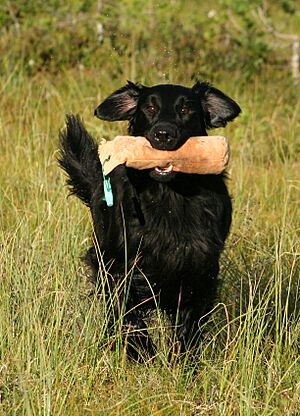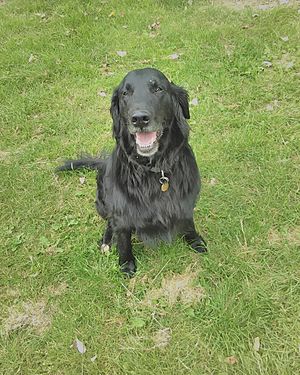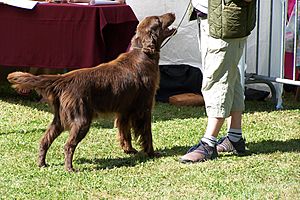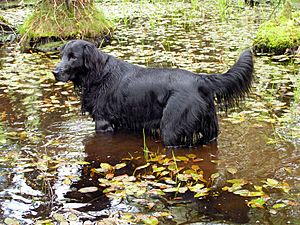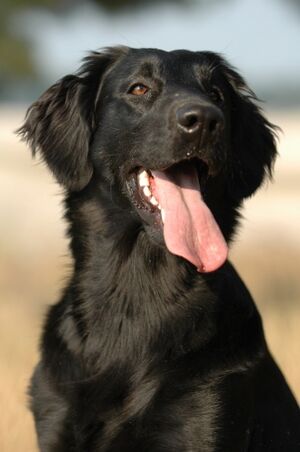Flat-coated Retriever facts for kids
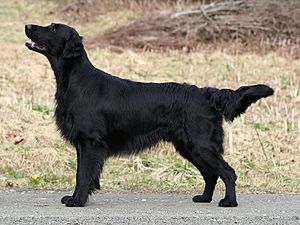
A black Flat-Coated Retriever
|
|||||||||||||||||||||||||||||||||
| Common nicknames | Flatcoat, Flattie Flatte (Sweden), flatt (Sweden) |
||||||||||||||||||||||||||||||||
|---|---|---|---|---|---|---|---|---|---|---|---|---|---|---|---|---|---|---|---|---|---|---|---|---|---|---|---|---|---|---|---|---|---|
| Origin | England | ||||||||||||||||||||||||||||||||
|
|||||||||||||||||||||||||||||||||
|
|||||||||||||||||||||||||||||||||
| Domestic dog (Canis lupus familiaris) | |||||||||||||||||||||||||||||||||
The Flat-Coated Retriever is a friendly dog breed from England. People first bred them to be gundogs. This means they helped hunters find and bring back birds on land and in water. They are known for their happy and energetic personalities.
Contents
About Flat-Coated Retrievers
What Do Flat-Coated Retrievers Look Like?
Flat-Coated Retrievers are medium to large dogs. Male dogs are usually about 59 to 61.5 cm (23 to 25 inches) tall. They weigh between 27 and 36 kg (60 to 80 pounds). Female dogs are a bit smaller. They are about 56.5 to 59 cm (22 to 24 inches) tall. They weigh 25 to 34 kg (55 to 75 pounds).
They have strong jaws and a snout that is not too short. Their head shape is special to the breed. It looks like one smooth piece. Their eyes are dark brown and shaped like almonds. They often have a smart and friendly look. Their ears are small and hang close to their head.
Flat-Coated Retrievers have a straight, strong back. Their tail is covered in feathers and held straight out. They move easily and gracefully. Their fur is shiny and smooth. It can be black or a dark brown color called liver.
What is Their Personality Like?
Flat-Coated Retrievers are very active and smart dogs. They love to please people. They are full of energy, confident, and outgoing. This makes them wonderful family pets. They can be good with children. However, adults should always be nearby. This helps guide the dog's playful energy.
They usually get along well with other dogs. They can even be good with cats. These dogs need a lot of exercise. They also need fun activities to keep them busy. This helps them use their natural energy. The British Kennel Club suggests at least two hours of exercise every day.
Flat-Coated Retrievers might bark to protect their home. But they are not usually aggressive. They have an excellent sense of smell. They also love to please their owners. Because of this, they are sometimes used as drug-sniffer dogs. They also help in programs to train guide dogs for the blind.
These dogs are eager to learn. They learn best in short training sessions. They can get bored if you repeat things too much. Flat-Coated Retrievers grow up slowly. They don't become fully mature until they are 3 to 5 years old. Even when they are older, they often act like puppies. This is why some people call them the "Peter Pan" of dog breeds.
Flat-Coated Retrievers enjoy being outdoors. They like natural activities. This includes rolling in mud or digging. They are also "thinking" dogs. This means they want to please you. But they might also try to find their own way to do things. This trait helps them when hunting. They work best when they have a strong bond with their owner.
History of the Breed
The Flat-Coated Retriever breed started in England in the mid-1800s. They became popular dogs for gamekeepers. Gamekeepers are people who manage wildlife for hunting. Some people think these dogs came from dogs brought from North America. These might have included the now-extinct St. John's water dog. Canadian sailors may have brought Newfoundland dogs to British ports. These dogs also helped create the Flat-Coated Retriever.
Other dog types were added to the breed. Collie-type dogs might have made them easier to train. Newfoundland dogs added strength. Setter dogs helped improve their sense of smell. The first Flat-Coated Retrievers appeared around 1860. But the final look of the breed was set about 20 years later.
When they came to the U.S., they quickly became popular as hunting dogs. The American Kennel Club officially recognized them in 1915. However, their popularity soon went down. Other breeds, like the Golden Retriever, became more popular. Golden Retrievers were actually partly bred from Flat-Coated Retrievers.
After World War II, there were very few Flat-Coated Retrievers left. People worried the breed might disappear. But in the 1960s, careful breeding brought them back. The breed became popular again. People liked them for dog shows and as family pets. Today, Flat-Coated Retrievers are still loved. Breeders work to keep them healthy and well-behaved.
In 2011, a Flat-Coated Retriever named Jet won "Best in Show" at Crufts. Crufts is a very famous dog show in Scotland. Other Flat-Coated Retrievers have also won important awards there. These wins have helped the breed become more popular in Europe and the United Kingdom.
Health of Flat-Coated Retrievers
Breeders should test Flat-Coated Retrievers used for breeding. This helps check for health problems that can be passed down. These problems include issues with hips, hearing, and eyes. Eye problems can include progressive retinal atrophy and glaucoma. Sometimes, these dogs can also have epilepsy.
Flat-Coated Retrievers can get sick with cancer more often than many other dogs. Types of cancer like hemangiosarcoma and fibrosarcoma are common in them. Sadly, the average lifespan for a Flat-Coated Retriever is about 8 to 10 years. A large number of them pass away due to cancer.
Another common health issue is a serious stomach problem called bloat. This can happen to many large, deep-chested dogs. If not treated quickly, it can be deadly. Bloat causes about 5% of all Flat-Coated Retriever deaths.
Compared to other medium-sized breeds, Flat-Coated Retrievers have fewer problems with hip dysplasia. This is a condition where the hip joint doesn't form correctly. They also have a low rate of luxating patellas. This is when the kneecap slips out of place.
See also
 In Spanish: Cobrador de pelo liso para niños
In Spanish: Cobrador de pelo liso para niños


